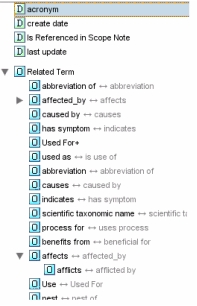- From: Sini, Margherita (KCEW) <Margherita.Sini@fao.org>
- Date: Mon, 14 Jan 2008 12:36:05 +0100
- To: Antoine Isaac <aisaac@few.vu.nl>, Bernard Vatant <bernard.vatant@mondeca.com>
- Cc: Dale Mead <dmead@nortel.com>, public-swd-wg@w3.org, public-esw-thes@w3.org
- Message-id: <BA453B6B6B217B4D95AF12DBA0BFB6690269F966@hqgiex01.fao.org>
If this can help, also in FAO we are specialising the RT relationships of the AGROVOC thesaurus, and we have adopted similar approach: to create a hierarchical tree of relationships, in top of which there is the traditional RT (skos:related). Attached a screenshot of the organized relationships. If needed I can provide a document describing our approach. Regards Margherita -----Original Message----- From: public-swd-wg-request@w3.org [mailto:public-swd-wg-request@w3.org] On Behalf Of Antoine Isaac Sent: 26 December 2007 18:18 To: Bernard Vatant Cc: Dale Mead; public-swd-wg@w3.org; public-esw-thes@w3.org Subject: Re: skos:related typing Hi Dale, Bernard, I support Bernard's proposal. this is how I would have done it, also. The SKOS Primer we're working on now (first bake in coming days!) has a small section which encourages that kind of specialization of the SKOS model. Cheers, Antoine PS: and a happy new year to all of you :-) > > Hi Dale > > At first sight, and unless I miss something more subtle, your problem > could be managed simply using subproperties of skos:related. > You will have for example > > ex:compatibleWith rdfs:subPropertyOf skos:related > > This kind of declaration allows your application to handle any > specific functionalities you want to attach to ex:compatibleWith, and > a vanilla skos application would handle it as any skos:related property. > > Bernard > > Dale Mead a écrit : >> I have been lurking on this list for a few months trying to catch up >> with the discussion. My apologies in advance if my question is >> something that has been dealt with in previous discussions that I >> haven't found. >> >> Background for my question: We are a running a production >> semantic(ish) engine that maintains an enterprise thesaurus driving >> cataloging and facetted navigation for knowledge management and our >> corporate intranet. We currently have 45K Concepts with 500K+ >> documents associated with those concepts and have been in production >> since 1997. >> >> As part of an enterprise rearchitecture, we are looking at the >> feasibility of using SKOS as a vehicle for providing thesaural >> information to other enterprise systems outside of the KM, DM, and >> web domains as a web service. >> >> Most of what I see in SKOS maps very cleanly into what we have been >> doing for the last 10 years with the differences mainly being in what >> we called things and, of course, in that we aren't currently >> expressing in XML because XML was not yet a standard in 1997. The >> biggest delta is with skos:related. In my context, I need to be able >> to track not just that there exists a relationship, but what the >> nature of that relationship is. An easy example out of many: >> >> Product A is our product. Products B and C are products of a >> competitor. Product A is related to Product B as a competing product >> (which allows us to do things like put competitive intelligence >> materials about B on A's intranet page). Products A and C are >> related because Product A is compatible with Product C. That is, we >> can sell our Product A into an established Product C environment. >> The information that I want to give the sales person is our story >> about that compatibility rather than competitive information about >> Product C. I can easily come up with a couple of dozen other >> situations where I want typed relationships. >> >> My inclination is that I want to put an additional rdf attribute in >> the skos:related element to indicate the type of relationship. >> However, if I have been reading this discussions on this list >> correctly, I shouldn't be adding additional formal attributes within >> skos elements. (Is this a correct understanding?) >> >> Has this issue been addressed within the SKOS discussions? >> >> >> >> >> >> >> >> >
Attachments
- image/jpeg attachment: hierarchical_rt.jpg

Received on Monday, 14 January 2008 11:36:49 UTC